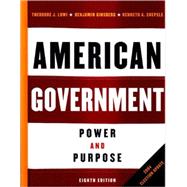In the Eighth Edition, American Government: Power and Purpose maintains the analytical rigor, focused pedagogy, and judicious use of relevant history that have distinguished it as the authoritative text for American government courses. Retaining the analytical framework that first appeared in the Seventh Edition, the Eighth Edition emphasizes five core "Principles of Politics":
1. All political behavior has a purpose
2. All politics is collective action
3. Institutions matter
4. Political outcomes are the products of individuals' preferences and institutional procedures
5. History matters
By drawing on these principles throughout the text, the authors expose students to repeated applications of core ideas in their discussion of political concepts and history. The result is a refined, accessible portrait of America's government institutions and political life that encourages students to think critically and analytically.








